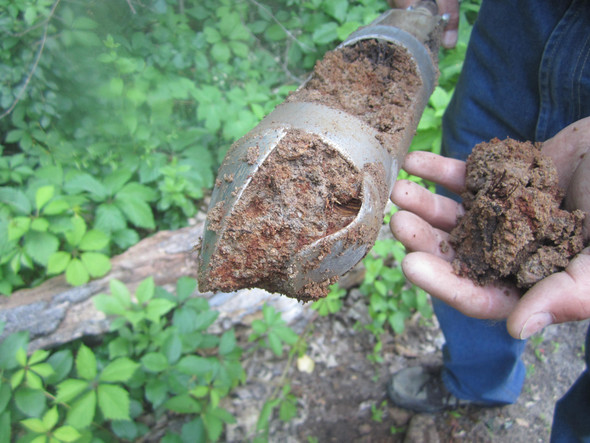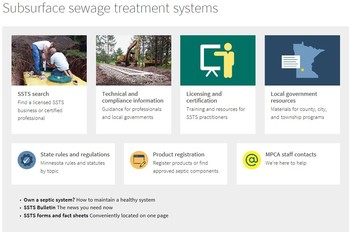
The topic of soil/separation verification requirements for LGUs and/or inspectors when inspecting new or existing SSTS systems has come up often, including during SSTS Talking Tours hosted by the MPCA across the state the past few years.
The issue often raised is this: When can an inspector complete a compliance inspection of an existing SSTS system without conducting a soil observation? Or, in other words, what constitutes acceptable “prior documentation” when conducting an existing system compliance inspection?
There is a related question as well, and that is: Going forward, what process (actions, documentation, etc.) should LGUs and inspectors follow when inspecting newly installed systems to ensure that adequate prior documentation will be available during future compliance inspections?
The MPCA has developed guidance information to help answer these questions and provide LGUs and inspectors with a process to follow in both situations. Please note that the following information serves as an interpretation of Minnesota Rule. This is not a new policy, nor a new rule. As such, the guidance contains several direct references to Minn. R. 7080 and Minn. R. 7082.
Soil/separation verification when inspecting existing systems
Here is the process and documentation requirements related to soil/separation verification when conducting a compliance inspection on systems installed before this guidance.
- The inspector should work with each LGU (usually a county) individually to determine what prior documentation is available for a particular system.
- The LGU will determine whether the available records are acceptable to be used as prior documentation and will inform the inspector of its decision. The LGU will also provide the inspector an opportunity to review the documentation.
- Regardless of the LGU’s decision on the adequacy of the prior documentation, the inspector always retains the right to conduct a new soil boring if, in their professional judgement, a new boring is appropriate.
- In other words if the LGU determines that the prior documentation is inadequate, the inspector must do a soil boring to properly complete the inspection. If the LGU determines that the prior documentation is adequate, the inspector can still use his or her professional judgement to determine if a new soil boring is appropriate.
- If the inspector has any questions about a system, or if the owner or owner’s agent requests one, a new soil boring/analysis can always be conducted.
Going forward: Process/documentation for inspecting systems installed after this guidance
From now on, LGUs and inspectors should follow the guidance below on required soil/separation documentation for new systems, which will help ensure that information is available during future compliance inspections that meets “prior documentation” requirements.
Minnesota rule 7082.0500 subp. 1 B states:
“A local unit of government with an SSTS ordinance adopted under part 7082.0040, subparts 2 and 3, must have a permit program that specifically addresses the following:
(1) permit application requirements;
(2) site, design, and soil review and approval requirements and procedures;
(3) record keeping; and
(4) reporting to the commissioner”
Minnesota rule 7082.0500 subp. 3 A states:
“An infield verification of the periodically saturated soil or bedrock at the proposed soil treatment and dispersal sites must be conducted by a qualified employee with jurisdiction or licensed inspection business who is authorized by the local unit of government.”
Minnesota Rule 7082.0700 subp. 3 C states:
“Local units of government must develop a certificate of compliance document or use a certificate of compliance developed by the agency for new construction and replacement. The certificate of compliance for new construction and replacement must include the vertical separation distance report described in subpart 4, item B, subitem (2)”
Minnesota Rule 7082.0700 subp. 4 B (2) states:
“A soil separation compliance assessment must be completed by a licensed inspection business or a qualified employee inspector with jurisdiction. Compliance must be determined either by conducting new soil borings or by prior soil separation documentation made by two independent parties. The soil borings used for system design or previous inspections are allowed to be used. If the soil separation has been determined by two independent parties, a subsequent determination is not required unless requested by the owner or owner's agent or required according to local regulations.”
Please note – “Vertical separation distance report” was found in Minn. R. 7082.0700 subp. 4 B (2) from 2008-2011. In 2011 the rule language was modified to “soil separation compliance assessment.”
Adequate documentation for determination of soil separation at the time of existing system compliance inspections must include, at a minimum, the following from Minn. R. 7080.1720 subp. 5:
- Soil depths
- Soil color (including matrix, mottling and redox colors)
- Rock fragments
- Soil texture
Justifications for these four minimum criteria is as follows.
Soil depths are required in order to accurately separate different soil horizons within the soil observation. Specifically, they are required on existing system compliance work in order to differentiate between upper and lower topsoil areas. Soil colors are required in order to correctly identify when topsoil, subsoil, mottles, and redoximorphic features are present. Also, these colors allow for distinctions between soil features and soil horizons.
Rock fragments are a requirement of an existing system compliance inspection in order to verify whether bedrock is present or not. The definition of bedrock (Minn. R. 7080.1100 subp. 8) contains rock fragments (Minn. R. 7080.1100 subp. 66a) as an indicator of a bedrock condition, and therefore a lack of vertical separation (Minn. R. 7080.1100 subp. 91).
Finally, soil texture is a required component of an existing system compliance inspection soil observation. The following rule citation (Minn. R. 7080.1720 subp. 5 item F) contains the requirement for soil texture.
- depth to the periodically saturated soil for all existing systems, determined by redoximorphic features in item E, except subitems (2), unit (a), and (3), units (a), (c), and (d), as measured outside the area of system influence in an area of similar soil;
Specifically, it is located in Minn. R. 7080.1720 subp. 5 E (3) (b).
(b) organic soil textures or mineral soil textures with an organic modifier
When an organic soil texture, or mineral soil texture with an organic modifier is present in the upper 12 inches of topsoil, and that topsoil is followed immediately by a periodically saturated horizon the soil texture must be recorded.
An LGU that verifies all of the requirements of a design soil observation and documents the equivalent soil criteria (Minn. R. 7080.1720 subp. 5) will cover more than the minimum soil documentation requirements for an existing system compliance inspection. An additional option available to LGU’s is to do shared soil observations with the SSTS designer. In the event that this method is employed signatures by both certified individuals on one soil observation log is acceptable.
What constitutes adequate prior soil verification documentation?
Minn. R. 7082.0700 Subp. 4 B (2)
“(2) A soil separation compliance assessment must be completed by a licensed inspection business or a qualified employee inspector with jurisdiction. Compliance must be determined either by conducting new soil borings or by prior soil separation documentation made by two independent parties. The soil borings used for system design or previous inspections are allowed to be used. If the soil separation has been determined by two independent parties, a subsequent determination is not required unless requested by the owner or owner's agent or required according to local regulations.”
The following documentation is required for existing system compliance inspections. This is NOT a new policy but a reiteration/clarification of existing rule interpretation and educational teachings over the past decade:
|
1†
|
1. Designer soil observation logs – verifies depth of limiting condition
2. LGU verification soil observation logs (can be separate or shared boring logs but must be signed) – verifies depth of limiting condition
Initial COC had been issued for the system* – verifies adequate vertical separation by indicating system installed at a depth in accordance with approved design
|
|
2†
|
1. Designer soil observation logs – verifies depth of limiting condition
2. Inspector existing system COC with attached soil observation logs – verifies depth of limiting condition and adequate vertical separation
|
|
3†
|
1. Inspector existing system COC with attached soil observation logs – verifies depth of limiting condition and adequate vertical separation
2. Inspector existing system COC with attached soil observation logs, if the inspector is independent of the inspector in item 1. – verifies depth of limiting condition and adequate vertical separation
|
† Documentation used to verify vertical separation must accurately determine site conditions e.g. Soil observations outside of area of influence, elevations tied to known benchmarks, soil observations in areas of similar soil, etc.
*If initial COC documentation does not exist for a system, then an inspector must physically inspect and verify adequate vertical separation exists between the bottom of distribution media and the limiting condition. They can either verify the depth of limiting condition by using previous soils documentation from two independent parties as specified in options 1-3 above, or by conducting new borings at the time of inspection.
NOTE: Documentation and inspections must be conducted in a manner such that no conflicts of interest exist and must be in accordance with Minn. R. 7082.0700 subp. 2 B – E.
Final word: Good communication between LGUs/inspectors key
It is important to determine what information is available from the LGU prior to conducting an existing system compliance inspection. By determining what information is available, and working with the LGU to understand new construction inspection practices at the time of installation, the inspector can make a more accurate determination of system compliance based on existing documentation. The goal of an existing system compliance inspection, regarding vertical separation, is to verify the depth of periodically saturated soil and to verify the depth of the bottom of the distribution media to confirm that adequate separation, and therefore treatment is occurring. If the preceding information cannot be ascertained via previous documentation, then an infield verification should take place. Remember, an infield verification can always be conducted to determine the correct answer.
Finally, please note that in situations where a contemporary, or current, infield verification is conducted the only way to dispute those findings is via the soil dispute process in Minn. R. 7082.0700 subp. 5. In other words, once an infield verification is completed and finds a system to be failing, previous verification documentation cannot, by itself, be used to change the compliance status of the system.
Questions on these items can be directed to Aaron Jensen at 651-757-2544 or Aaron.S.Jensen@state.mn.us.

By Cody Robinson
Thanks to feedback from LGUs and other SSTS stakeholders around the state, we have finally completed a long overdue project aimed at improving the navigability and content provided in the SSTS section of the MPCA website.
The changes include:
- a redesigned landing page organized by audience
- improved navigation of subpages
- more concise content, and most notably,
- one easily accessible page housing all web-available forms and fact sheets provided by the MPC. Click on the links below and take a look for yourself.
Main landing page.
Forms and fact sheets.
This project is a direct reflection for how the suggestions of those we work with influence our practices. With that said, the MPCA is always seeking feedback on our website. If you have any thoughts or suggestions on the content we provide online, please don’t hesitate to call Cody Robinson (MPCA – St. Paul) at 651-757-2535 or by email at cody.robinson@state.mn.us.
|
|